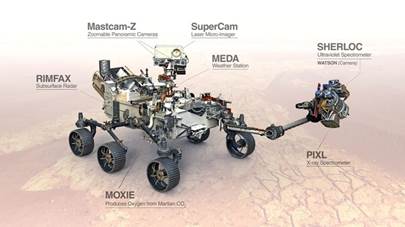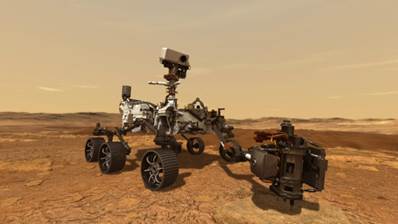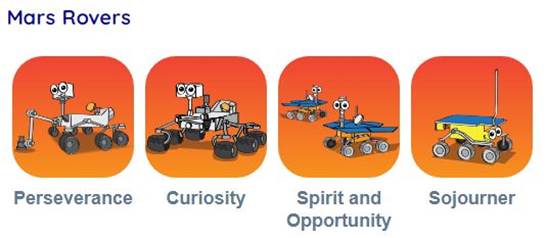Description

Disclaimer: Copyright infringement not intended.
Context
- NASA’s Perseverance rover has found surprising volcanic rocks in Mars’ Jezero Crater, which was once a lake.
Watch: https://www.youtube.com/watch?v=aKK7vS2CHC8
About
- Perseverance, nicknamed Percy, is a car-sized Mars rover designed to explore the crater Jezero on Marsas part of NASA's Mars 2020 mission.
- Perseverance has been active on Mars for 130 sols (133 Earth days) since its landing.
- Following the rover's arrival, NASA named the landing site Octavia E. Butler Landing.
- Perseverance has a similar design to its predecessor rover, Curiosity, from which it was moderately upgraded.
- It carries seven primary payload instruments, nineteen cameras, and two microphones.
- The rover also carried the mini-helicopter Ingenuity to Mars, an experimental aircraft and technology showcase that made the first powered flight on another planet on 19 April 2021.

|
Broad Objectives of Mars 2020 Mission
· Looking for habitability: identify past environments that were capable of supporting microbial life.
· Seeking bio-signatures: seek signs of possible past microbial life in those habitable environments, particularly in specific rock types known to preserve signs over time.
· Caching samples: collect core rock and regolith ("soil") samples and store them on the Martian surface.
· Preparing for humans: test oxygen production from the Martian atmosphere.
|
Read: iasgyan.in/daily-current-affairs/nasas-perseverance-mission

Jezero Crater
- Jezero Crater is 28 miles (45 kilometers) wide, and is located on the western edge of a flat plain called Isidis Planitia, which lies just north of the Martian equator. The landing site is about 2,300 miles (3,700 kilometers) from Curiosity's landing site in Gale Crater.
- Location: North of the Martian equator, in the Isidis Planitia region (18.4 degrees north / 77.5 degrees east)
- Diameter: 45 kilometers
- Jezero Crater sits within the Isidis Planitia region of Mars, where an ancient meteorite impact left behind a large crater some 1,200 kilometersacross. This event is known as Isidis impact, and it forever changed the rock at the base of the crater.
- A later, smaller meteorite impact created the Jezero Crater within the Isidis impact basin. Scientists believe that these events likely created environments friendly to life. There is evidence of ancient river flow into Jezero, forming a delta that has long since been dry. Jezero Crater is thus likely to have been habitable in the distant past.
All about Mars
- Mars is a cold desert world. It is half the size of Earth. Mars is sometimes called the Red Planet. It's red because of rusty iron in the ground.
- Like Earth, Mars has seasons, polar ice caps, volcanoes, canyons, and weather. It has a very thin atmosphere made of carbon dioxide, nitrogen, and argon.
- There are signs of ancient floods on Mars, but now water mostly exists in icy dirt and thin clouds. On some Martian hillsides, there is evidence of liquid salty water in the ground.
- Scientists want to know if Mars may have had living things in the past. They also want to know if Mars could support life now or in the future.
Structure and Surface
- Mars is a terrestrial planet. It is small and rocky.
- Mars has a thin atmosphere.
- Mars has an active atmosphere, but the surface of the planet is not active. Its volcanoes are dead.
Time on Mars
- One day on Mars lasts 24.6 hours. It is just a little longer than a day on Earth.
- One year on Mars is 687 Earth days. It is almost twice as long as one year on Earth.
Mars’ Neighbors
- Mars has two moons. Their names are Phobos and Deimos.
- Mars is the fourth planet from the Sun. That means Earth and Jupiter are Mars’ neighboring planets.
Quick History
- Mars has been known since ancient times because it can be seen without advanced telescopes.
- Several missions have visited Mars. And Mars is the only planet we have sent rovers to. They drive around Mars, taking pictures and measurements.

https://www.downtoearth.org.in/news/science-technology/nasa-rover-perseverance-captures-eclipse-involving-mars-satellite-phobos--82512

















